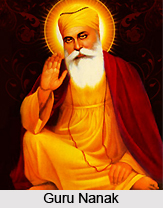 Guru Nanak, the founder of Sikhism, was born in a small village in a Hindu family and became spiritually inclined at a very early age. His entire life was spent in teaching the postulates of Sikhism. He travelled far and wide to propagate the philosophy which later came to be known as the Sikh philosophy. The account of Guru Nanak`s early life can well be learnt from the Janam Sakhis. All the Janam Sakhis stand as biographical accounts of Guru Nanak. The Miharban Janam Sakhis provides the details of Nanak`s early life. It gives account of Nanak`s birth. The background of his family is also included in the Janam Sakhis. It also mentions every detail right from the time of his birth. The Janam Sakhis mention that right from the age of five he had distinctly showed his spiritual inclination. This Janam Sakhis also describes how at the age of nine, Nanak, rejected all kinds of external rituals and emphasised on the inward acceptance of the Almighty. As this Janam Sakhi proceeds it gradually gives account of the life of Nanak. It gives account of Nanak`s family as well as his growing spiritual tendencies.
Guru Nanak, the founder of Sikhism, was born in a small village in a Hindu family and became spiritually inclined at a very early age. His entire life was spent in teaching the postulates of Sikhism. He travelled far and wide to propagate the philosophy which later came to be known as the Sikh philosophy. The account of Guru Nanak`s early life can well be learnt from the Janam Sakhis. All the Janam Sakhis stand as biographical accounts of Guru Nanak. The Miharban Janam Sakhis provides the details of Nanak`s early life. It gives account of Nanak`s birth. The background of his family is also included in the Janam Sakhis. It also mentions every detail right from the time of his birth. The Janam Sakhis mention that right from the age of five he had distinctly showed his spiritual inclination. This Janam Sakhis also describes how at the age of nine, Nanak, rejected all kinds of external rituals and emphasised on the inward acceptance of the Almighty. As this Janam Sakhi proceeds it gradually gives account of the life of Nanak. It gives account of Nanak`s family as well as his growing spiritual tendencies.
An important section of the Miharban Janam Sakhis comprises the travel of Guru Nanak to Sultanpur in the company of Mardana. Nanak was requested by Jai Ram his brother-in-law to travel to Sultanpur. As Nanak reached Sultanpur he met Daulat Khan Lodhi and was entrusted a lot of duties by Daulat Khan. A legend in the Janam Sakhis also says that once Nanak had gone to take a bath in the river and from there he was transported to the divine court. As a result he was out of sight for sometime. When he returned he claimed, `There is neither Hindu nor Mussalman`. Due to this incident Nanak was questioned by Daulat Khan. Nanak with his answer satisfied and influenced Daulat Khan to a great extent and then had set out for his first journey with Mardana. In the very beginning Nanak had gone to an uninhabited land which was completely desolated. Mardana become intimidated with such a situation but Nanak assured him. Then they reached Delhi where Guru Nanak preached his philosophies to a number of people and all of them easily got converted to Sikhism. In a similar manner the Guru travelled to places like Haridwar, Allahabad, Varanasi and finally went on to meet Kabir. Guru Nanak carried on his expeditions and also travelled to a number of unnamed places as well and propagated the philosophy of a moral life. Almost all over the country Nanak travelled and wanted to spread the philosophy of the Lord.
The Miharban Janam Sakhis state that when Nanak had climbed the Mount Sumeru he had met all the nine Siddhs. The nine Siddhs whom he had found on Mount Sumeru were Gorakhnath, Machhen-dranath, Isarnath, Charapatnath, Barangnath, Ghoracholl, Balgundai, Bharathari, and Goplchand. As they asked him about the condition of the earth he had said that the world was war torn and was filled with falsehood and degeneration. Legend says that Nanak was taken to a divine court where he was given the responsibility of restoring righteousness on earth. After this incident Nanak again continued his journey and reached Gorakh-Hatari. Spending a year Nanak proceeded to the western part of the country where he reached Multan in the very beginning. In Multan also Nanak gathered a number of followers by teaching his philosophy which focused on the greatness of the Lord. From Multan, Guru Nanak had set out for Mecca. Legend has it that when he had reached Mecca he had challenged the Mullah on the occasion of sleeping in the mosque with his feet in the wrong direction. Though the Mullah had ordered punishment for Nanak yet at the end the Mullah was moved with the words of Nanak and took to death. Similarly another incident in Mecca also talks about the miraculous power of Guru Nanak when he was transported to the city of Mecca in an instant. From Mecca, Nanak proceeded towards Hinglaj to spread Sikhism.
The Puratan, Bala and the Gyan Ratnavali Janam Sakhis, on the other hand, accounts for Nanak`s visit to Ceylon. The Bala Janam Sakhis has mentioned two tales of Nanak`s visit to Ceylon. The first says that how Mansukh travelled to the land of Raja Sivanabh and converted the Raja into Sikhism. The second account talks about how Nanak himself travelled to Ceylon previously known as Sirighaladip to meet his royal disciple Raja Sivanabh. As per as the legend of visit to Ceylon is concerned it has a lot of confusions and ultimately the conclusion which can be found out is that there is not enough proof with regard to the visit of Nanak to Ceylon.
The story of Sajjan a thief is a popular one in the Sikh Holy Scriptures and has been mentioned in all the Janam Sakhis. Legend goes that Sajjan posed as a holy philanthropist in order to attract travellers towards him and in turn killed them. Various accounts have been given in all the Janam Sakhis with regard to the place of occurrence of the incident and also about the various facts that had taken place in the incident. The principal point about the story of Sajjan is that he had given up all his negative qualities after hearing to the hymn of Nanak. The hymn had made Sajjan realise the true nature of the Almighty and the benefits of leading a moral life.
Besides these, the guru`s visit to Assam also holds prime importance in almost all the Janam Sakhis. It talks about the visit of Guru Nanak and Maradana to a land which was led by female enchantress. The magical references that took place in the land were referred to as tantric practices. The first challenge that holds to this account of visit to Assam is that when Guru Nanak visited Assam it was not ruled by women. It was rather ruled by kings of Kamrup. The traditions which are followed in the local gurdwaras of Assam have been primarily derived from the accounts of Janam Sakhis. These traditions have been introduced in the land of Assam by the Khatri leaders, sadhus and soldiers and have been carried forward by the Sangats.
Regarding the foundation of Kiratpur it has been said that Guru Nanak had once visited the Kahlur Mountains where Budhan Shah a famous miracle worker lived. Nanak had easily inspired Budhan Shah and had said that his successor Baba Guruditta will visit Budhan Shah and will establish the city of Kiratpur. According to the words of Guru Nanak, Baba Guruditta came and laid the foundation of the city of Kiratpur. It was named Kiaratpur because the word Kirat meant praise for the Lord.
Thus, it is primarily, the Janam Sakhis that provide detailed accounts of Guru Nanak`s early life and his rise as one of the greatest religious and spiritual leaders of India.









